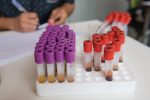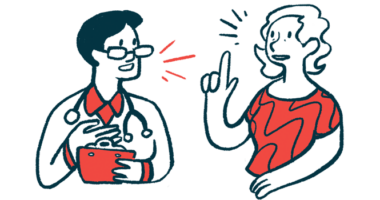Skin, Hives, and Scleroderma

Scleroderma, lupus, rheumatoid arthritis, Sjögren’s syndrome — all of these are autoimmune diseases. And they’re invading my every cell.
I’m displeased by how these diseases have made themselves at home in my body. We were doing just fine before they crashed the party!
The other day, as I was sitting there minding my own business, I felt something go from warm to hot, to super itchy, on my skin. It was the type of itchy that makes the tiny hairs on the head stand on end. It didn’t take long for me to go from wanting to lightly scratch it to an all-out effort to stop myself from using a Brillo brush all over my welted body.
I couldn’t get past one burning, itching eruption on my body before another one popped up. You could have played Connect the Lines with these new linear welts, a condition known as dermatographia. It looked like a wild, rabid animal had scratched me all over my body.
But it was me — I was the wild, rabid animal.
I searched my kitchen high and low. My mother had to help me make a baking soda paste. OK, I didn’t make the paste. My mother — my angel — had to make the paste because I was hopping from one foot to the other. The fire had moved to my legs, and I looked like the hives had whipped me.
Mix up the paste. Dance around like no one is watching you do the itchy dance.
I tried my best to be patient with the paste-application process, but a severe desire to scratch myself made it a tad difficult. The itching fire soon made its way up the entire length of my legs, and the paste wasn’t working nearly as fast as I wanted it to.
In a last-ditch effort to protect my sanity, I applied ice packs to my red and burning legs, which welcomed the cold sensation. After a long 10 minutes, the itching began to subside, and I could finally breathe.
Yes, ice packs relieve the itching! You will thank me.
I take daily medication for chronic hives, which are associated with my scleroderma diagnosis. Dryness and itching are two of the worst symptoms. A Brillo pad attached to the end of a long pole would be my go-to solution for the itching, but doctors frown upon that.
Here is a hard-learned tip for you: Scratching makes it worse. So stop scratching!
When I could, I drove to the emergency room. Hives of this nature signify an allergic reaction and should be treated as an emergency. I wasn’t experiencing anaphylaxis, but driving wasn’t the best idea, as one hand was on the steering wheel while the other was ready to scratch to the bone.
I didn’t have to wait there long. I think it was the fire red skin that proudly displayed its itchy welts that allowed me quicker passage behind the emergency room doors. It was a pretty quick process after those doors swung close behind me.
The nurse started my IV with apparently enough Benadryl to kill an elephant. Wow! It was night-night time for me. As my eyes closed, all I could think of was for the itching to be gone. It was indeed a sweet release.
A few moments later, the itching had stopped, but the welts were still there, holding firm. But they didn’t stay around long!
I found out I was allergic to Macrobid (nitrofurantoin), an antibiotic. Did you know you can get hives from an allergic reaction to medicine even two weeks after taking it? I didn’t.
Living with scleroderma, one finds so many ways to soothe the skin while having hive flares. But I’ll admit, itching is one of the worst symptoms I experience.
Here is another awesome tip: Do not do the itchy dance with baking soda paste. It will be messy when you clean it up!
***
Note: Scleroderma News is strictly a news and information website about the disease. It does not provide medical advice, diagnosis, or treatment. This content is not intended to be a substitute for professional medical advice, diagnosis, or treatment. Always seek the advice of your physician or other qualified health provider with any questions you may have regarding a medical condition. Never disregard professional medical advice or delay in seeking it because of something you have read on this website. The opinions expressed in this column are not those of Scleroderma News or its parent company, Bionews, and are intended to spark discussion about issues pertaining to scleroderma.








Robin Davis
What are the ingredients of the baking soda paste?
Amy Baker
I mixed baking soda and cold water. I made it pretty thick. Then I applied it all over. You have to work fast because it'll dry up pretty quickly.
Shelley Graves
I've had similar issues. I keep a bottle of Benadryl in my med cabinet. Yes ice does help the itching too. They ER has I
An injection that will stop the itching. I love shellfish. I can eat a limited amt of shrimp, but use caution with crab meat. My ankles and feet are always involved
Amy Baker
Yes! I keep Benadryl in all forms lying all over the place for easy reach. They gave me an injection which helped. It gave me over 24 hours of relief during this recent flare. I LOVE shellfish also. My grandma was the same way. She could eat a little, but there was a point where it was too much, and it would bring on a reaction. We never knew how much. Looking back, we probably played shrimp roulette. :)
Nancy Kendall
What a good sense of humor! She made me smile.
Amy Baker
Thank you so very much! I am so glad I was able to make you smile. :)
Tracey Kenard
My son has Scleroderma (I word I'd never heard of in my life) and breaks out in blister rashes. He never complains so I don't usually know he's in pain until I notice the rash. So far, Triple Antibiotic Cream (over the counter) gives him relief, but the tricky thing with these autoimmune diseases is you never know WHAT your body is going to do from one day to the next. I'm glad you found relief. I was getting itchy just reading this. Thanks for sharing.
Amy Baker
My love and light to you and your son! Thank you for being his rock to lean on. You are correct! It's like a symptom roller coaster. It is a ride, and I look forward to NOT being on.
Sheri Olshan
Thanks so much for this post! As a 45-year Ltd Scleroderma warrior, I was surprised last year by the arrival of hives on exposure to a certain plant. That is resolved but an area at the base of my skull continues - I didn’t realize hives were common in these conditions. Always learning! Take good care of yourself.
Amy Baker
WOW, did you say 45 years??? Bless you!!! Yes, hives are our nemesis. It is incredible how much we learn with this type of autoimmune disease. Thank you and please take good care of yourself.
Judith Pranger
Are there any pictures of the different rashes on skin? Docs don't seem to know a lot about schleraderma disease
Carol Edwards
Try spray starch for hives. It works quick and easy to apply.
Amy Baker
Carol, that is an exciting remedy. I will have to try that next time! I would have done anything to stop the itch.
Lindajean
Yes I have experienced this horrible sensation and allergic reaction to who knows what. My tounge (misspelled) will also swell causing my teeth to rest on top of said thickened part of my mouth. I go to the Doc. and yes they see this but they simply discount it and tell me to go home my scleroderma is not active it's something else. I apologize but I have lost much faith in our Medical System in my state. I end up trying to figure out how to take care of myself in everything that is part of this illness. I'm very glad that others seem to have more success, I truly am. Nobody out there should suffer, & if you can get something help I am truly happy. Your story hit home right to my own trying to sit in baking soda baths. Take care all you silent warriors.
Amy Baker
I am so sorry your doctor has discounted you. If you have that type of reaction, it could be anaphylaxis, and you need to get to the emergency room next time. I, too, have lost faith. It wasn't until I had one rheum who listened that I realized many amazing people in the medical field. Please search around and find a doctor who will listen and learn. You are your biggest advocate!
Edward King
I used to experience hives and itching in the evening after my shower. I have been taking antihistamine such as Zirtec, Xyzal, Desloratadine or similar. It works satisfactorily for me. I think Benadryl is also an antihistamine. Applying a medicated (OTC) body lotion helps to relieve the itching.
Amy Baker
Yes, I, too, get them after a hot shower. I currently take Zyrtec daily. It seems to stay in my system longer. I am glad you found something that works for you.
Joan Summers
One day I woke up to red, hot, itchy welts on my leg that hurt like crazy. I was afraid I had Shingles and felt so relieved when the urgent care doctor told me it was hives. I end up with hives for 7 straight months that year. I'd go into work with one of my eyes half shut, my mouth swollen up and red welts everywhere. I would literally have them from the top of my head to the bottoms of my feet. I would buy four boxes of Aveena collodial oatmeal bath soak at a time and put two packets into my bathwater at once. Then I'd sit in the cool water with the oatmeal for as long as I could, just because I was getting a little relief. I like the Children's liquid benedryl. I would drink it straight from the bottle. It would help and I could still function. My regular doctor and my rheumy were stumped. I even had a biopsy of one of the hives to see what was up with it. It came back that I had (wait for it), Hives.
They eventually went away and not long after that Iwas diagnosed with a new autoimmune disease to go along with my Lupus - Systemic Scerloris. I had no idea what that was and went home to look it up online and cried myself to sleep. I did NOT want that.
But here I am. I still swell up with hives on ocassion, but much less severely and not very often anymore. Still don't know why. I'm grateful for this website and people's stories about what they are dealing with with this disease. I wish there were more personal stories given.
Amy Baker
Joan, I want to thank you for sharing your story. I, too, have lupus and can understand your reaction. It is ok to cry and release those emotions. Receiving a new diagnosis is challenging. I tried to do a baking soda paste but found the only thing that helped was ice. I am not an ice person because I have Raynauds but it helped! I am so so sorry you had to experience this awful symptom. We have to be our own voice and I am so happy to share and hear personal stories.
Pam
That sounds horrible!! I luckily do not have to deal with hives,but I keep getting these tiny little bumps...the only thing I can think of is like tiny warts...all over my fingers,and they sometimes itch like crazy.They are mainly on the outer sides of my index fingers.Doctor I've talked to so far seems clueless about them
Amy Baker
Hi Pam! I would certainly check it out with a dermatologist. I hate itching no matter where it comes from, and I am so glad you don't have hives! I hope you find some relief!
Kim H
I also had no idea the itchies went hand in hand with scleroderma. I’ve noticed In the past 6-12
Mos being more prone to itches after showers. Yes, tbrouroigy rinsed showers! I’ve found cooler water and most any clear like wash help. It can say “gentle” all over it, but if it’s a white or colored, thick cream style soap, I will itch. Most clearish ones help a ton. Also, Benedryl, and aloe. The real aloe straight from the plant.
Amy Baker
Oh my goodness Kim, I totally feel your pain. I have an actual aloe plant also. I have had to use ice packs to relieve mine but it does work. I am sorry you have to deal with this issue!
Valerie Romero
Hello everyone. I recently had a first time bout of bumps all over my chest under my neck. they started small and grew in size becoming very hot and itchy. I have never dealt with any type of rash on my body before so naturally I was very concerned. I went to my primary Doctor and she had no idea what was going on, she suggested I see a dermatologist. I traveled out of town to see the dermatologist and was told I had folliculitis. I was given a strong antibiotic and topical antibiotic to use. I used the topical antibiotic and hoped for the best. The oral route is really hard on my body so I did not take it. I and my primary Doc did not agree with the folliculitis diagnosis. Finally the rash disappeared as if it was never there leaving me really stumped. If this a common occurrence for systemic scleroderma I surely would like to know more about this so I can know how to prevent it. I relayed this to my Rheumatologist and I did not get much info from her. I am learning about this disease as I go. I was diagnosed about 4 years ago and not given much info regarding what to expect. I do go through the itchy skin process which is worse for me in the winter. I live at an elevation of 10,200 feet and have almost 7 months of winter. I have pulmonary hypertension and I am on oxygen 24 hours along with bi pap at night. I have the raynauds under control with meds. Speaking of meds, I am under a lot of meds. That was my first thought regarding the hives, could it be one of my meds? Thanks for letting share my frustrations!
Cecily Alleyne
Can you use oatmeal and baking soda paste solution on your skin also if you are taking liquid benadryl?
Amy Baker
Yes ma'am! You certainly can. It makes quite a mess. Trust me, I had to sweep it up. LOL!
Cecily Alleyne
I too had hives first time I ever had them,it is scary, apparently if you get them in your throat you have to get medical help immediately,geez!!.
Marta N.
I get spontaneous hives. I went to see an allergist. He said you have an autoimmune desease. Well I was diagnosed with scleroderma a while back. So that i knew. He prescribed a daily allergy pill. He said claritin ok. I cannot take benadryl. Severe reaction to it. I am to return in 3 months so he can see if i have had any more incidents. Since starting claritin i am fine.